Common AWS Storage Options: Which One Fits Your SMB?
Explore essential AWS storage options for SMBs, comparing S3, EBS, EFS, and Glacier to find the best fit for your data needs.
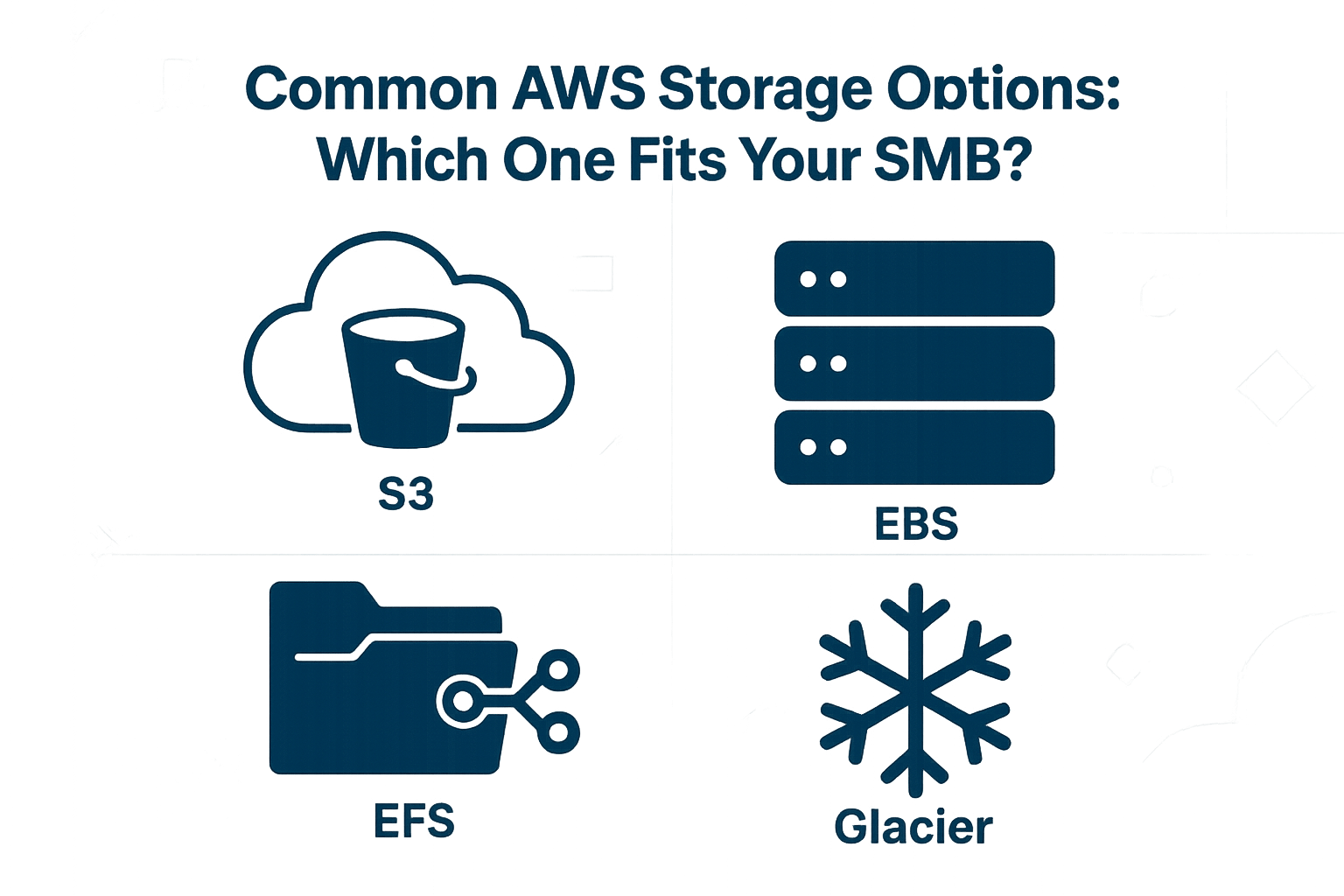
- Amazon S3: Scalable object storage for websites, backups, and data analytics.
- Amazon EBS: High-performance block storage for databases and applications.
- Amazon EFS: Shared file storage for collaborative workloads.
- Amazon Glacier: Low-cost archival storage for long-term data retention.
Quick Comparison Table
| Feature | Amazon S3 | Amazon EBS | Amazon EFS | Amazon Glacier |
|---|---|---|---|---|
| Storage Type | Object | Block | File | Archival |
| Best Use | Backups, websites | Databases, applications | Shared file systems | Long-term archives |
| Access Speed | Milliseconds | Sub-millisecond | Low-latency | Minutes to hours |
| Cost (per GB) | From £0.018 | From £0.074 | From £0.264 | From £0.00079 |
| Scalability | Unlimited | Up to 16 TB per volume | Elastic, auto-scaling | Unlimited |
Key Takeaways
- S3 is great for static websites or storing large datasets.
- EBS is ideal for high-speed, low-latency workloads like databases.
- EFS supports multiple users accessing shared files.
- Glacier offers the cheapest option for storing rarely accessed data.
Choose based on your performance needs, access patterns, budget, and scalability requirements. Each service includes strong security features and pay-as-you-go pricing to suit growing SMBs.
AWS Storage - S3 vs EBS vs EFS Comparison
1. Amazon S3: Object Storage
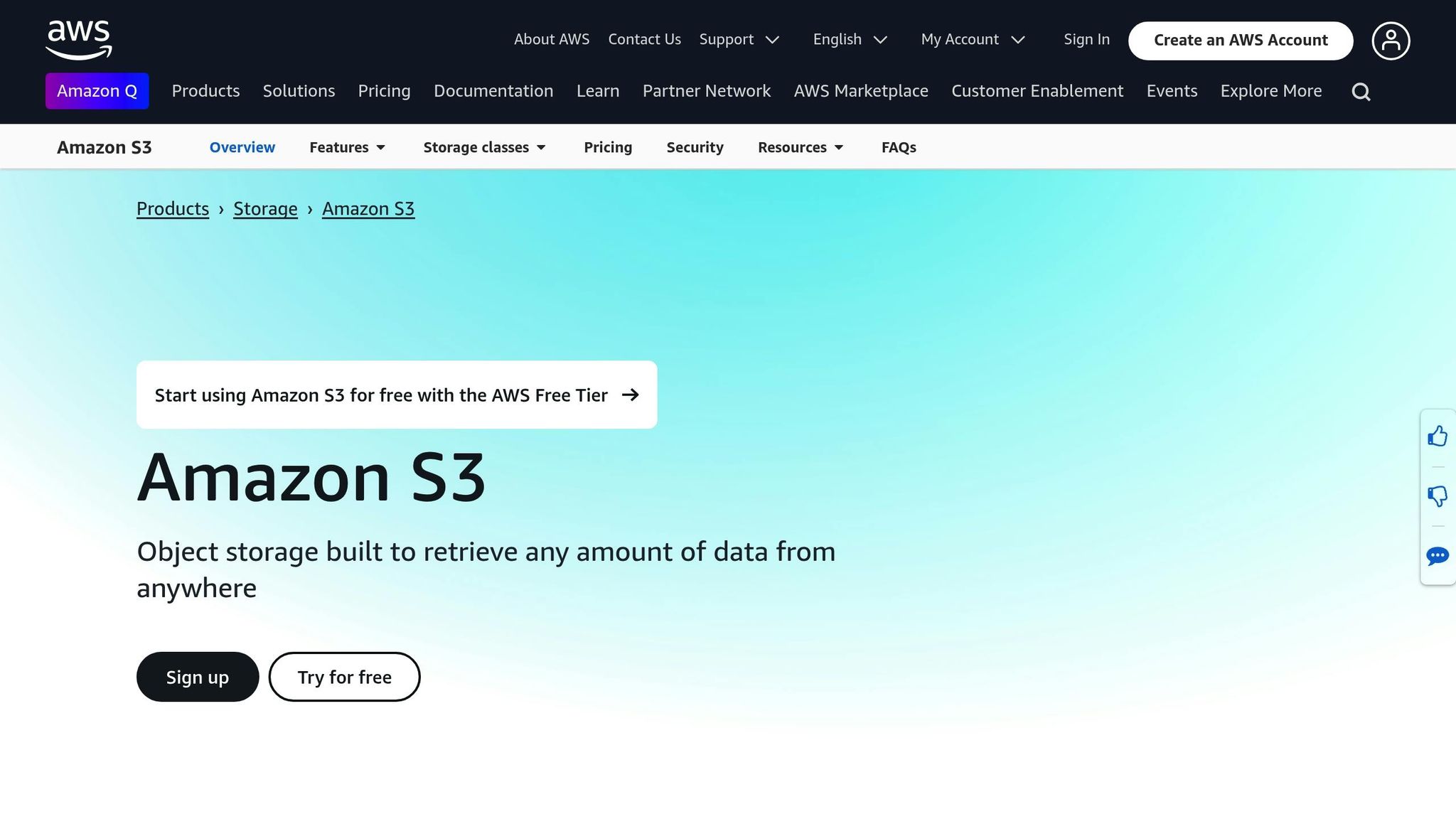
Amazon S3 is a key storage solution for small and medium-sized businesses (SMBs), offering scalability and reliability. It’s built to handle over 350 trillion objects and process more than 100 million requests per second. S3 provides enterprise-level storage at prices accessible to SMBs.
Key Features
Amazon S3 offers an impressive 99.999999999% data durability and 99.99% availability. This makes it a dependable choice for storing critical business data. It also grows with your data, removing the need for complex capacity planning.
| Storage Class | Cost per TB/Month | Use Case |
|---|---|---|
| S3 Standard | £14.72 | Frequent access; website hosting |
| S3 Intelligent-Tiering | £14.72 (Frequent Access) | Unpredictable access patterns |
| S3 Standard-IA | £10.00 | Infrequent access; backups |
| S3 Glacier Instant Retrieval | £3.20 | Archives accessed quarterly |
Cost Efficiency
S3 uses a pay-as-you-go pricing model, which includes a free tier:
- 5GB of S3 Standard storage
- 20,000 GET requests
- 2,000 PUT, COPY, POST, or LIST requests
- 100GB of data transfer per month
This model helps businesses manage storage costs effectively.
Real-World Example
The BBC provides a powerful example of S3 in action. In November 2022, they migrated 25 petabytes of archive data to S3 Glacier Instant Retrieval. The project, completed in 10 months, involved transferring 120 terabytes daily and allowed them to retire half of their physical infrastructure.
"By using Amazon S3 Glacier Instant Retrieval and Amazon S3 Intelligent-Tiering, we get archive-like pricing models for content that we previously had in relatively hot storage", explains Tom Cartwright, Executive Product Manager at the BBC.
This case highlights S3's ability to handle large-scale, complex projects efficiently.
Best Use Cases
Amazon S3 is ideal for:
- Hosting websites and distributing content
- Backing up and archiving data
- Big data analytics
- Machine learning workflows
- Static website hosting
Its strength lies in handling read-heavy workloads.
Security and Compliance
S3 includes robust security features to protect your data:
- Default encryption
- Detailed access controls
- Built-in auditing tools
- Compliance with key regulatory standards
These features make S3 a secure choice for both regulated industries and general business needs. Up next, we’ll explore AWS’s block storage options to see how they compare to S3.
2. Amazon EBS: Block Storage
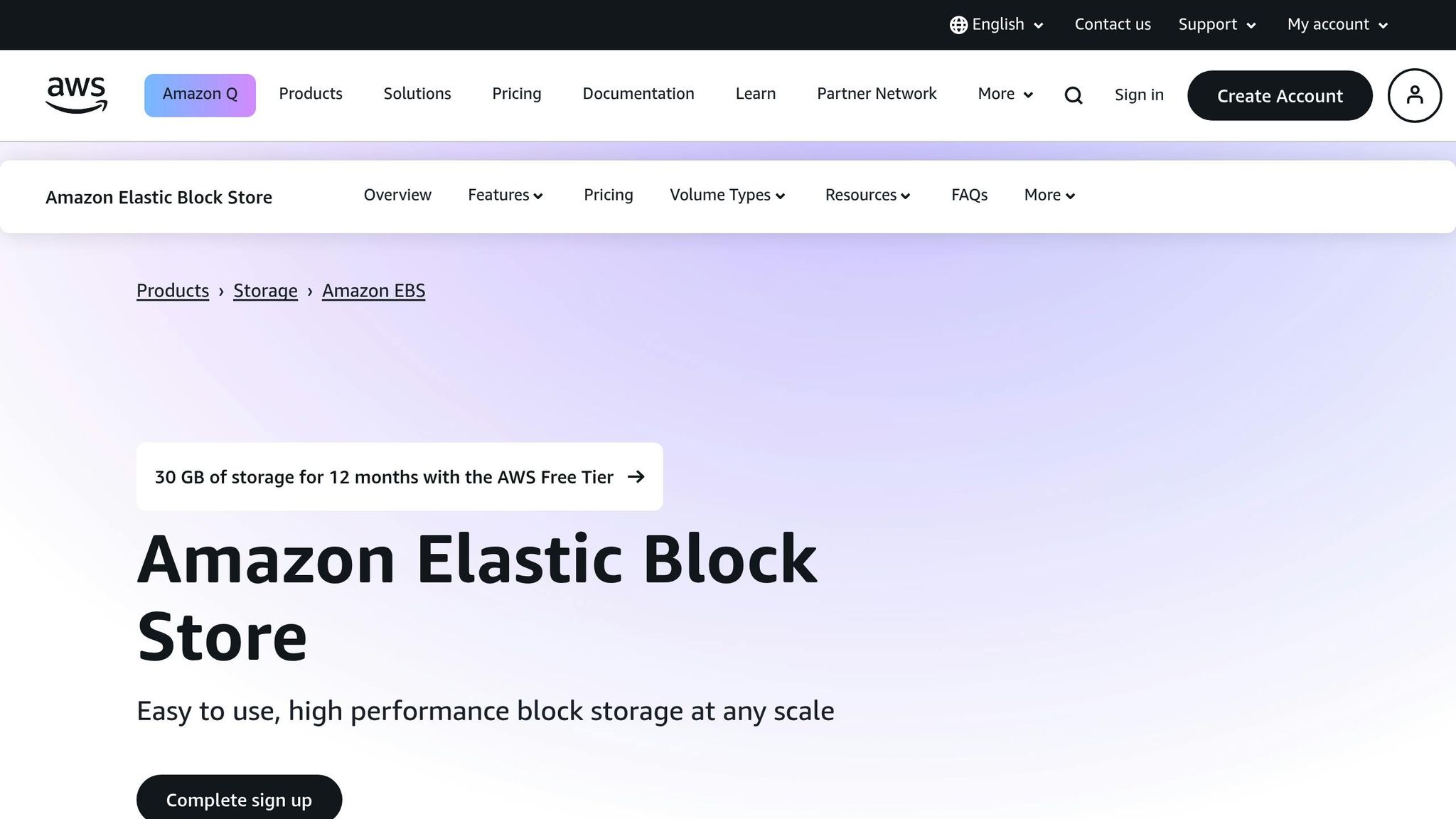
Amazon Elastic Block Store (EBS) is a block storage service designed to work seamlessly with EC2 instances. It’s a dependable option for small and medium-sized businesses (SMBs) that need consistent storage performance. EBS boasts impressive durability rates: 99.999% for io2 Block Express volumes and 99.8–99.9% for other volume types.
Volume Types and Performance
EBS offers several volume types to suit different workloads:
| Volume Type | Ideal For | Base Performance | Cost per GB/Month |
|---|---|---|---|
| gp3 (SSD) | General workloads | 3,000 IOPS, 125 MB/s | £0.08 |
| io2 (SSD) | Critical applications | Custom IOPS | £0.125 |
| st1 (HDD) | Big data, warehousing | 250 MB/s | £0.045 |
| sc1 (HDD) | Infrequent access | 80 MB/s | £0.015 |
Cost-Effective Storage Management
For SMBs, the AWS Free Tier is a great starting point, offering:
- 30 GB of storage
- 2 million I/O operations
- 1 GB of snapshot storage
Real-World Success
ProtectWise, a cybersecurity company, showcased how EBS can significantly cut costs. By adopting a stateless storage architecture combining EBS and S3, they achieved:
- A 95% reduction in storage costs
- Faster data retrieval, with searches completed in 1–3 seconds
- Enhanced operational efficiency
"Nobody else in the security industry can do this. It blows our customers away."
– Gene Stevens, Co-founder and CTO of ProtectWise
Key Features for SMBs
EBS includes several features that are especially useful for growing businesses:
- Dynamic Scaling: Adjust storage capacity and performance without downtime.
- Data Protection: Built-in encryption for volumes and snapshots ensures secure storage.
- Automated Management: Tools like Data Lifecycle Manager simplify backup automation.
- High Availability: Automatic replication within Availability Zones keeps your data accessible.
Performance Optimisation
Switching from gp2 to gp3 volumes can reduce storage costs by up to 20%, while still delivering 3,000 IOPS and 125 MB/s throughput. Gp3 volumes also offer a predictable baseline performance and allow you to scale IOPS and throughput independently to match your workload needs.
Monitoring and Management
To keep storage efficient and costs under control, consider these practices:
- Track storage metrics with CloudWatch
- Monitor expenses using Cost Explorer
- Ensure storage and compute resources are in the same Availability Zone
- Automate snapshot management for backups
Next, we’ll compare these AWS storage options to help you determine which is the best fit for your SMB.
3. Amazon EFS: File Storage
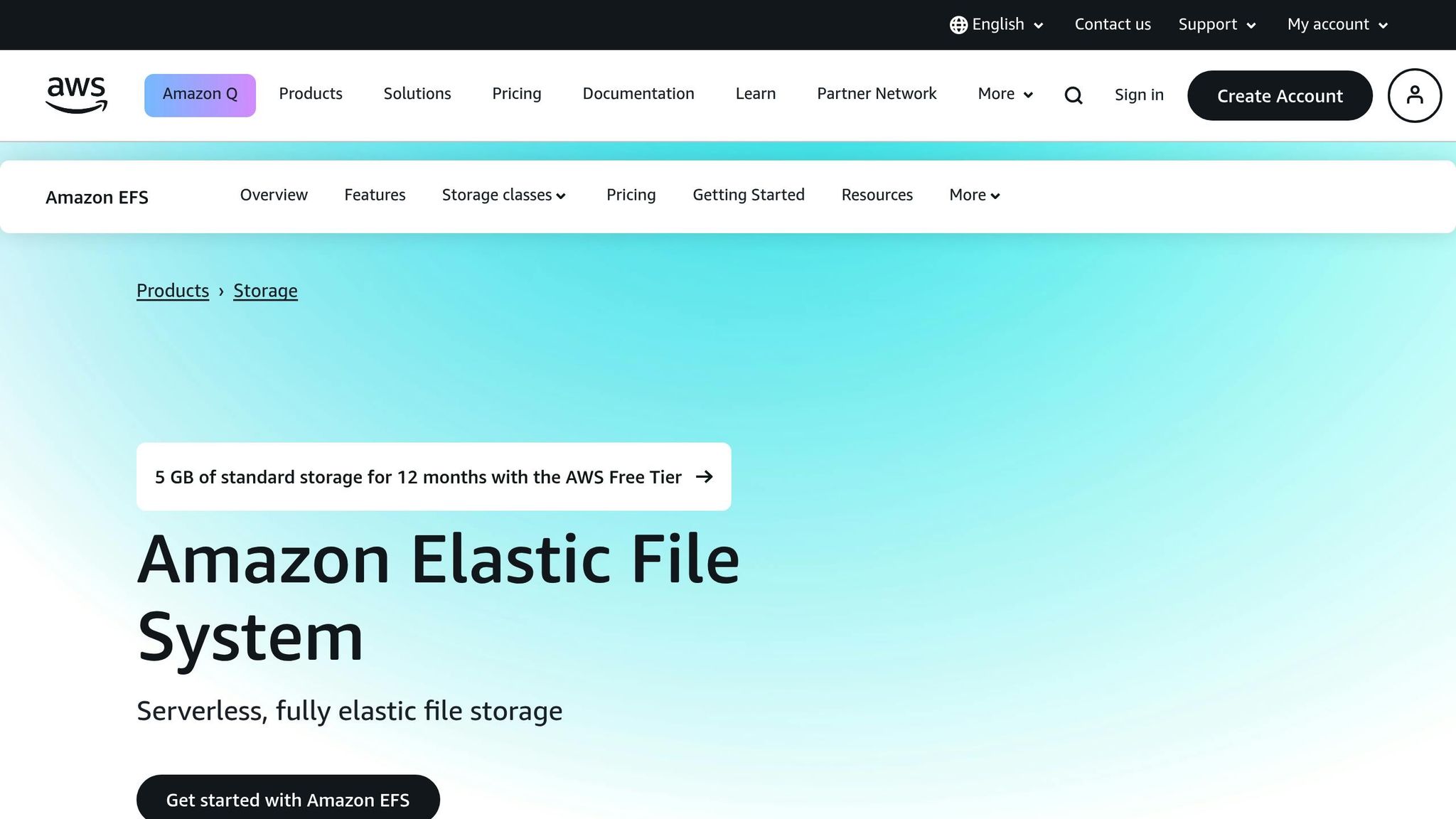
Amazon Elastic File System (EFS) provides scalable and flexible file storage for AWS compute instances and on-premises servers. It offers an impressive 99.999999999% durability and up to 99.99% availability. This makes EFS a dependable shared storage solution that grows alongside your business.
Storage Classes and Managing Costs
EFS comes with three storage classes tailored to different data access needs:
- Standard: Best for frequently accessed data, offering sub-millisecond latency.
- Infrequent Access: Suited for less frequently accessed data, still with low-latency performance.
- Archive: Designed for rarely accessed, long-term data storage.
Pricing for these classes depends on the AWS region.
Real-World Examples
EFS has proven its value for many organisations. For instance, Discover Financial Services reduced storage costs by 50%, Johnson & Johnson sped up data analysis by 35%, and Ancestry simplified onboarding for their scientists.
Key Features
- Automatic Scaling: Expands storage capacity seamlessly, even to petabyte levels, without downtime.
- Shared Access: Supports thousands of simultaneous connections.
- Security: Includes built-in encryption and integrates with AWS Identity and Access Management (IAM).
- Cost Efficiency: Lifecycle management options can cut expenses by up to 97%.
Performance and Use Cases
EFS offers two throughput options:
- Elastic Throughput: Charges based on actual usage, adjusting dynamically.
- Provisioned Throughput: Lets you reserve a specific performance level in advance.
EFS is commonly used for:
- Content management systems
- Database backups
- Developer environments
- Media processing
- Big data analytics
- Container storage
Tips for Saving Costs
- Use lifecycle management to automatically move less-accessed files to cheaper storage classes.
- Opt for EFS One Zone for workloads that don’t require multi-zone redundancy.
- Take advantage of the AWS Free Tier, which includes 5 GB of EFS Standard storage for 12 months.
- Monitor file access patterns to choose the most cost-effective storage class.
Next, we’ll explore AWS Glacier, a solution for long-term storage needs.
4. Amazon Glacier: Long-term Storage
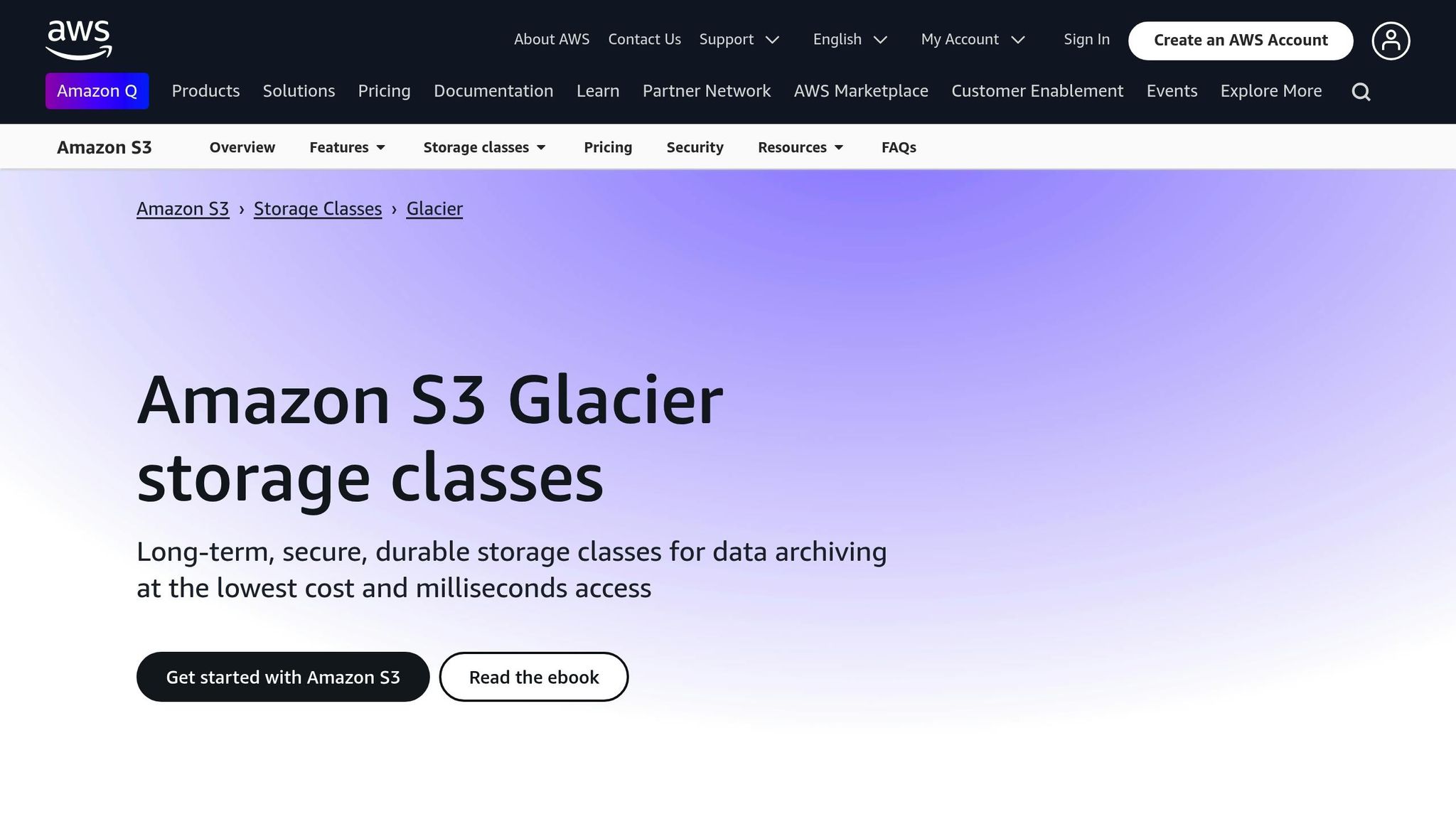
Amazon S3 Glacier provides a cost-effective solution for long-term data archiving, offering an impressive 99.999999999% durability while adhering to EU GDPR regulations.
Storage Classes and Their Uses
Amazon S3 Glacier includes three storage tiers, each tailored to specific archival needs:
| Storage Class | Retrieval Speed | Best For | Cost Savings |
|---|---|---|---|
| Glacier Instant Retrieval | Milliseconds | Quarterly access | Up to 68% cheaper than S3 Standard-IA |
| Glacier Flexible Retrieval | Minutes to hours | Access 1–2 times per year | Up to 10% cheaper than Instant Retrieval |
| Glacier Deep Archive | 12–48 hours | Rarely accessed data (less than once a year) | Up to 75% cheaper than Flexible Retrieval |
Cost Structure for UK SMBs
For small and medium-sized businesses in the UK, Glacier Deep Archive offers storage costs as low as approximately £0.00079 per GB per month (around £0.80 per TB per month). This makes it an attractive option for businesses looking to manage large-scale archives affordably.
Key Features
Security and Compliance
- Data encryption at rest for added security
- Integration with AWS CloudTrail to log API activity
- WORM (Write Once, Read Many) functionality via S3 Object Lock
- Full compliance with EU GDPR standards
Cost Management
- No upfront costs - pay only for what you use
- Flexible pay-as-you-go pricing
- Automated lifecycle policies to manage data transitions
- Free data retrieval for up to 10 GB per month
These features make Glacier a practical choice for businesses aiming to balance security, compliance, and cost-efficiency.
Practical Implementation Tips
- Organise Your Data: Combine smaller files into larger bundles to minimise per-object storage costs.
- Plan Retrievals: Match retrieval speed to your needs:
- Use Instant Retrieval for frequently accessed historical data.
- Opt for Flexible Retrieval for occasional internal backups.
- Choose Deep Archive for rarely accessed documents like compliance records.
- Optimise Costs: Set up lifecycle policies to automatically move data between storage tiers, ensuring maximum cost efficiency.
When to Choose Glacier
Amazon Glacier is ideal for UK SMBs that need to:
- Archive compliance-related documentation
- Maintain long-term backup solutions
- Store historical customer data for future reference
- Safeguard financial records beyond standard retention periods
- Preserve completed project files for archival purposes
Storage Options Comparison
This section breaks down AWS storage services based on performance, scalability, and cost to help SMBs make informed decisions.
Quick Reference
| Feature | Amazon S3 | Amazon EBS | Amazon EFS | Amazon Glacier |
|---|---|---|---|---|
| Storage Type | Object | Block | File | Archival |
| Primary Use | Static content, backups | Databases, boot volumes | Shared files, CMS | Long-term archives |
| Access Speed | Milliseconds | Sub-millisecond | Low-latency | Minutes to hours |
| Monthly Cost | From £0.018/GB | From £0.074/GB | From £0.264/GB | From £0.00079/GB |
| Scalability | Unlimited | Up to 16 TB/volume | Elastic, auto-scaling | Unlimited |
Performance Characteristics
Each service offers unique benefits depending on your workload:
- Amazon S3: Best for read-heavy tasks like content delivery and data lakes. Its unlimited capacity makes it a strong choice for SMBs with growing storage needs.
- Amazon EBS: Delivers low-latency, consistent performance, making it ideal for databases and application hosting. With sub-millisecond speeds, it’s perfect for I/O-intensive tasks requiring immediate responses.
- Amazon EFS: Balances performance with shared access. It supports multiple EC2 instances accessing data simultaneously. While not as fast as EBS for single-instance tasks, it’s reliable for shared workloads.
- Amazon Glacier: Focuses on cost savings, with retrieval times ranging from minutes to hours. It’s well-suited for storing compliance documents and historical data.
Cost Comparison for UK SMBs
Storage costs vary by service and usage patterns:
| Storage Service | Standard Rate (First 50 TB/Month) | Data Transfer OUT | Additional Notes |
|---|---|---|---|
| S3 Standard | £0.018/GB | £0.074/GB | Free tier includes 5 GB |
| EBS (gp3) | £0.074/GB | N/A within AZ | IOPS charges apply after 3,000 |
| EFS Standard | £0.264/GB | N/A within AZ | Includes lifecycle management |
| Glacier Deep Archive | £0.00079/GB | Retrieval fees apply | Minimum 90-day storage required |
Manoj Kalyanaraman, CTO at Dropsuite, highlights the cost benefits of S3:
"Amazon S3 is a massively scalable storage service that we use to serve our growing number of customers worldwide. By optimising our Amazon S3 usage, we can stretch our IT budgets and extend the impact of our technology".
Access Patterns and Integration
- S3: Accessible via APIs and integrates seamlessly with services like Redshift and Athena.
- EBS: Attaches directly to EC2 instances for fast access.
- EFS: Allows multiple EC2 instances to connect simultaneously, ideal for shared environments.
- Glacier: Works with S3 lifecycle policies for automated archiving.
Security and Compliance
All services include strong security measures and comply with industry standards. Choose the one that aligns with your workload and budget while meeting your performance needs. This comparison provides a clear starting point to select the right AWS storage for your business.
Choosing Your Storage Solution
Selecting the right AWS storage option means aligning the service's capabilities with your data access patterns, budget, and growth plans. This guide helps small and medium-sized businesses (SMBs) find the best AWS storage option based on their specific needs.
Assess Your Access Requirements
Start by understanding how your data is accessed. Here's a quick comparison of AWS storage options based on access patterns:
| Access Type | Solution | Best For |
|---|---|---|
| Frequent, immediate access | EBS | Database servers, application hosting |
| Variable, shared access | EFS | Content management, development environments |
| Web content delivery | S3 Standard | Media files, static websites |
| Rarely accessed archives | S3 Glacier Deep Archive | Compliance records, historical data |
Once you've identified your access needs, consider cost-saving measures to make the most of your storage solution.
Cost-Optimisation Strategies
Reduce costs with automated tiering and lifecycle policies:
- S3 Intelligent-Tiering: Automatically moves objects to the most cost-effective storage tier based on access patterns. Pricing starts at £0.0020 per 1,000 objects.
- Configure lifecycle policies to transition rarely accessed data to lower-cost storage tiers, such as S3 Glacier.
Compliance and Data Protection
Ensure your storage solution meets compliance requirements. AWS offers tools to help:
- KMS: Encrypt your data.
- IAM: Manage access control.
- CloudTrail: Track and audit data access.
For data sovereignty, store sensitive information in a UK region like London (eu-west-2).
Growth Planning
AWS storage services are designed to grow with your business:
- S3: Provides nearly unlimited scalability with 99.999999999% durability.
- EBS: Offers low-latency block storage, ideal for predictable growth.
- EFS: Automatically scales and uses a pay-as-you-go pricing model.
"The cloud enables you to succeed with instant, affordable storage capacity that you can scale up or down as needed. You make no new investments in equipment and pay only for the storage resources you use." – AWS
Performance Optimisation Tips
Tailor your storage choice to your workload demands for better performance:
| Workload | Storage Service | Advantage |
|---|---|---|
| High-IOPS databases | EBS (io2) | Sub-millisecond latency |
| Shared file access | EFS | Consistent low latency across multiple instances |
| Static content delivery | S3 + CloudFront | Global content distribution |
Choosing the right combination of storage and performance features ensures your system runs efficiently and supports your business's long-term goals.
FAQs
How can I choose the most cost-effective AWS storage option for my business's data needs?
To choose the most cost-effective AWS storage option, start by evaluating your data access patterns and requirements. For frequently accessed data, S3 Standard is a great choice, while S3 Infrequent Access offers lower costs for less frequent use. If your access patterns vary, S3 Intelligent-Tiering automatically moves data to the most cost-efficient tier.
If you need high-performance storage for applications like databases, EBS provides low-latency, block-level storage. For large volumes of unstructured data, S3 is ideal, while Glacier is best for long-term archiving at minimal cost. Regularly review your storage usage and consider lifecycle policies to optimise costs by moving data between storage classes as needed.
Finally, keep in mind that AWS storage options like S3 offer excellent durability and availability, making them suitable for backups and disaster recovery. Tailor your choice to your business’s specific needs, balancing performance, scalability, and budget constraints.
What are the main differences in performance and scalability between Amazon S3, EBS, EFS, and Glacier for small and medium-sized businesses?
For small and medium-sized businesses (SMBs), understanding the key AWS storage options can help you choose the right solution for your needs:
- Amazon S3 is highly scalable and perfect for storing large amounts of unstructured data, such as backups or media files. It’s ideal for read-heavy workloads and global data access.
- Amazon EBS delivers fast, low-latency block storage for applications that require quick data access, such as databases or high-performance workloads.
- Amazon EFS is a shared file storage solution designed for use across multiple instances. It scales automatically with your storage needs and supports high performance, making it great for collaboration or workloads requiring concurrent access.
- Amazon Glacier is best for storing archival data at a low cost. It’s suited for data you don’t need to access frequently but still want to keep securely.
Each service offers unique strengths, so your choice will depend on factors like scalability, budget, and how often you need to access your data.
How can I ensure my data stored in AWS services meets regulatory standards and stays secure?
To ensure your data in AWS complies with regulations and remains secure, start by leveraging AWS’s compliance tools. AWS supports global standards like PCI-DSS, HIPAA, and GDPR, and provides resources such as AWS Audit Manager for continuous monitoring and AWS Artifact for compliance reports.
Understand the shared responsibility model: AWS secures the infrastructure, but you are responsible for securing your applications, data, and access. Use AWS Identity and Access Management (IAM) to enforce least-privilege access and encrypt data both at rest and in transit. Regularly audit your S3 buckets to ensure they are not publicly accessible.
Automate security tasks using tools like AWS Security Hub and Amazon GuardDuty, which monitor and flag vulnerabilities. For added protection, enable S3 Versioning and Object Lock to prevent accidental deletions, and consider using Amazon Macie to identify sensitive data. Regular training for your team on security best practices is also essential to maintain a strong security culture.




